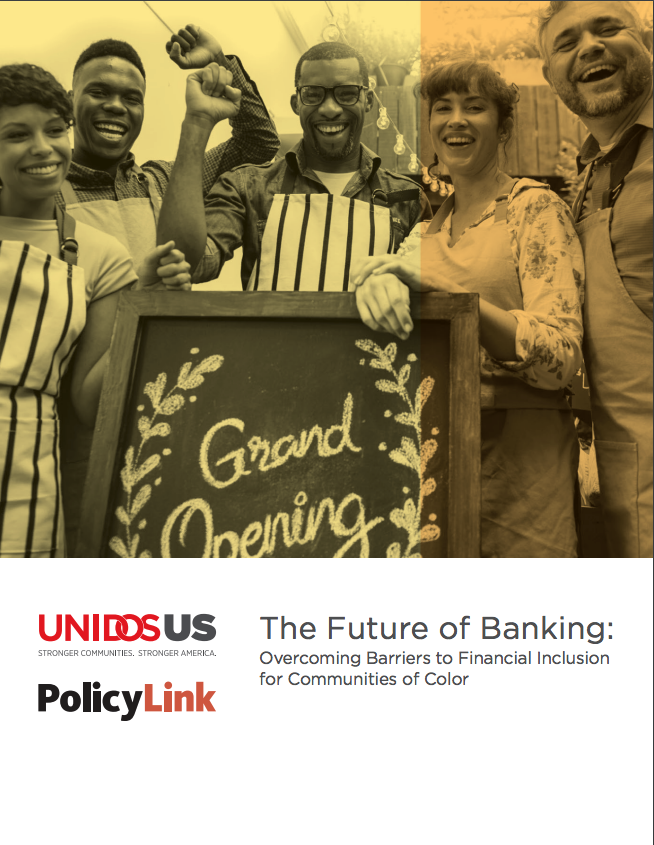Mobile banking: Latino millennials love it, but older generations don’t trust it just yet
By Beatriz Paniego-Béjar, Content Specialist, UnidosUS
Mobile phones are now an extension of our lives, especially for Hispanics. According to a study from the research group ThinkNow, “there are just over 46 million Hispanic mobile phone users and this number is expected to grow to 51 million by 2020,” and 93% of Latinos own either a smart phone or a tablet.

Following these trends, the use of online banking among Latinos is also increasing. According to UnidosUS and PolicyLink’s The Future of Banking: Overcoming Barriers to Financial Inclusion for Communities of Color, “in 2017, slightly more than one in four (25.8%) Latinos used online banking as their primary method to access their bank accounts” with younger generations feeling most comfortable with online banking.
Hope in fintech for LMI consumers
Different barriers exist for the use of mainstream financial products affecting low- and moderate-income (LMI) people of color. Prohibitive identification requirements, high-interest loans and fees, language barriers and lack of culturally relevant services, and scarcity of bank branches in their neighborhoods have left these populations with few options, and lead them to rely on alternative financial services (AFS). However, our The Future of Banking report explains how AFS “have historically left many households in perpetual cycles of debt and financial ruin.”
But now, a new avenue is opening: the financial technology sector, or fintech, is bringing LMI consumers a new option outside the mainstream financial institutions and alternative financial services. “Fintech has great potential to provide services to LMI consumers in an affordable way, because of their reduced physical footprint and online business model,” the report describes.
Their services are basically exclusively online and through smartphone apps, providing convenience and accessibility to unbanked (those in households where no one in the house has a checking or savings account) and underbanked (those in households where someone in the house has a checking or saving account, but still used AFS) individuals.
Furthermore, with financial services online and through apps, financial institutions have to invest less in bank branches, and those savings can be passed on to consumers.
The generational gap in online and mobile banking
All these perks brought by fintechs, however, are not meeting all of LMI consumers’ needs. There is still a preference in that face-to-face interaction that happens at bank branches when opening a bank account and dealing with certain financial concerns. “[P]hysical presence still has an impact on whether LMI communities of color are banked,” The Future of Banking reports via focus groups. “Not all respondents regularly used a physical branch location to deposit or withdraw funds, but nearly all respondents had opened their accounts in person at a financial institution. Most of the focus group participants had used online and mobile services, but when asked how they resolved questions or problems with an account, the majority said they preferred to resolve issues in person at a branch.”

However, the report also states that “bank branches bring benefits to LMI communities which are lost when branches close.” Bank branches are becoming scarce in LMI neighborhoods, with 25% of all rural bank closures in majority-minority census tracts, areas where most of the population are people of color.
This trend is making LMI consumers move toward online and mobile banking, but not without challenges. Many still say, “computers make so many mistakes.” Even though there are generational differences in the regular use of fintech, security and data protection are concerns many consumers have regarding mobile banking, especially since, being so new, fintech is not as regulated as traditional financial systems. Underregulation can lead to predatory practices similar to alternative financial services. But in spite of these concerns many are still using apps for banking. One focus group member shared, “she used apps for banking […] because she felt there were no alternatives to send and receive payments among many in her network.”
The report also shares the experience of one financial institution executive who noticed that fintech firms “get a lot of money behind them, but then they don’t know how to reach the consumers.” In turn, this can lead to the development of products that don’t have LMI consumers in mind, which leads to gaps in usability and access.
An area in which fintech can fail to accommodate the needs of LMI consumers is not taking into consideration language and generational barriers. The focus groups conducted in The Future of Banking report show that having apps in a user’s preferred language promotes use of fintech. The Spanish-speaking community in Chicago reported having more experience in using technology in their banking than the Thai or Cantonese-speaking focus groups.” The participants in these focus groups both saw fintech publicity in Spanish-language television, and could go online to learn how to use these apps.
When it comes to mobile banking, many Latino consumers must ask for help from younger community members. The ThinkNow study showed that millennial Latinos (18–34 years old) use more apps (33 apps) than the 35–64-year-old group (25.3 apps), and that collectivism is evident in app usage: “The majority have downloaded apps for others to use and share.”
Younger English-speaking Latinos feel more comfortable using fintech to bank than older Hispanics. Our report found they “were generally comfortable in trying new online banking services and in using features such as fingerprint identification to access them on their phones.”
Financial inclusion for all
Fintech presents new challenges and opportunities for LMI consumers. The generational gap older Latinos are facing while attempting to use digital and mobile banking is a real concern. Still, government agencies and community-based organizations can address it by creating programs to show this population how to manage and use digital financial tools.
In it’s current state, however, fintech is still not fully meeting the needs of LMI consumers despite the serious need for new and accessible ways of banking. The Future of Banking report presents recommendations to reform policy, products, and practices to advance financial inclusion, and concludes that: “Careful collaborations among financial institutions, fintechs, and government can lead to financial inclusion and success for those who are currently underbanked.”
We need a more equitable economy, that provides access to safe and productive financial services to LMI consumers of color and others who have historically been excluded. Innovative solutions, when properly checked can help consumers participate, prosper, and reach their full potential which will then impact the economic growth of our communities and our nation.


